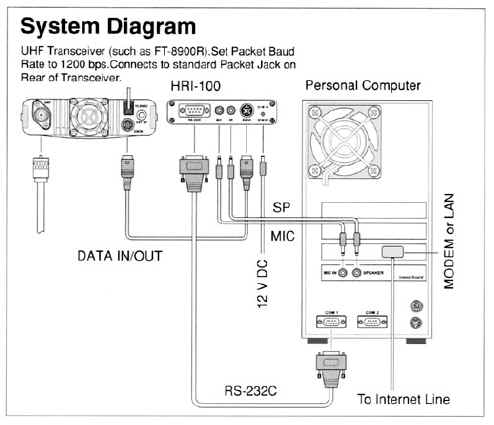

The things are going on...
you can call me via WIRES II node
#7124 D
any time. One of the first initial QSOs with JA6NKA done... Great toy !
I am the first German station on WIRES II System
Local users around Munich Attention!!
|
1 WIRES-II™ uses DTMF signaling to establish a bridge, using the Internet, from your repeater or home station to another WIRES-II™ equipped station anywhere in the world. No proprietary tones or connection formats are used, so any manufacturer's radio (equipped with a DTMF encoding keypad) may be used to bring up the Internet link.
2 At the repeater site, a personal computer is connected to the HRI-100 WIRES-II™ Interface Box, which serves as a command and audio-patching controller for the Internet bridge to your computer. Either a dial-up connection, or a high-speed line such as a DSL or ISDN line, may be used for connecting to the Internet.
3 The flexibility of the WIRES-II™ concept allows you to configure the system to allow on-the-fly selection of linked or non-linked communications. Therefore, in fast-moving emergency
communications situations where both local coordination and longer-distance reporting are required, WIRES-II™ allows local communications to be interspersed between linked transmissions. And because WIRES-II™ uses voice-recording technology as a buffer,
WIRES-!l™ calls will never interrupt a conversation in progress on a distant repeater.
4 WIRES-II™ provides two operating network concepts. Up to ten repeaters and/or home
stations may join together to form a "Sister Radio Group" for closed-network operations, ideal for emergency, school, or sister-city groups. You can call any repeater within your SRG group using a single DTMF digit. And the host WIRES-II™ server also maintains a world-wide listing of repeaters operating in the "FRG" mode ("Friends' Radio Group"), any of whom you may call using a six-digit DTMF string to establish a link.





If you are around Munich, Germany you are invited to try an qso via my wires node. Please check 439.575 PL154 for activities. Please try yourself, read the following instruction, check the availability of the node (... if I am at home), find a node number of another station and dial.
I suggest you try a first connection to a repeater station i.e.
#1159 N1IRL repeater in Budd Lake, NJ
# 1129 WA6RQD repeater in Southern California
# 1101 Vertex Standrad YAESU USA test node
# 5604 repeater in Kagoshima city Japan
WIRES-II allows every-day local communications, using hand-held or mobile transceivers, to expand into worldwide communications opportunities, using the magic of Internet linking. Using
simple DTMF commands, you can communicate with other WIRES-II nodes throughout the world, with outstanding audio quality.
Operating on an FRG Node
If your local repeater (or local station) has been set up as a WIRES-II FRG Node, operation is extremely simple.
Just go to the WIRES-II Home Page, and consult the "WIRES-II I.D. List" by clicking on the tab on the left side of the Home Page. Now click on the geographical area of interest to
you. When you find a Node that is of interest, jot down its I.D. number.
For example, to call node #1101D in California, close the PTT switch on your transceiver, then key in the [#][1][1][0][1][D] DTMF digits from your keypad. A link should be established, and you can just make a call as though you were operating on a regular repeater.
When your QSO is over, be sure to send the "disconnect" signal, which is either [#][9][9][9][9][9] or
[#][9][9][9][9][D].
During your QSO, it is possible that the other station may seem to disappear. If this happens, it is possible that the other station's Time-Out Timer may have terminated the link. Wait a few minutes, and try again, but do not immediately try to re-establish the link. When making an initial QSO, it is recommended that you keep your transmissions short until you come to know the Time-Out Timer settings for the other station.
Operating
Reminders for WIRES-II
Remember that the Node you are calling may be in a dramatically different time zone from yours, so if you don't get a response, be sure you're not calling in the middle of the night!
* The [A], [B], [C], and [D] DTMF keys are used for Group Calling within WIRES-II. So if you hit one of these keys, you may be calling as many as ten Nodes at once (consult your Node administrator for details). If possible, find out the I.D. Number of the
Node that is responding, so you can call that Node back directly (so as not to tie up multiple stations unnecessarily)
Note that some Nodes may not accept Group Calling.
When communicating via WIRES-II, be sure to use the "disconnect" signal (either [#][9][9][9][9][9] or [#][9][9][9][9][D]).
If your transceiver does not have DTMF capability, you may still be able to communicate via WIRES-II. For example, if someone your
repeater is engaged in a QSO, you may "break in" just as you would during any other type of repeater QSO (use common courtesy, as always!). However, SRG operation generally will not be possible without a DTMF-equipped transceiver.